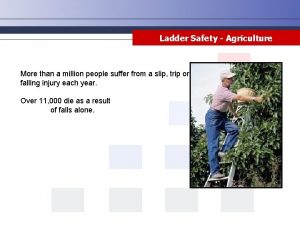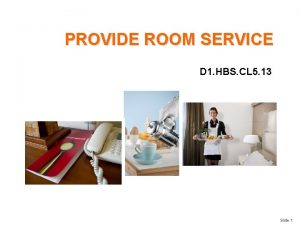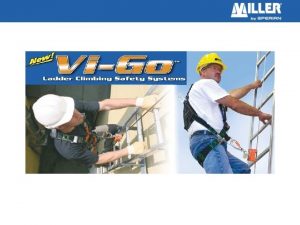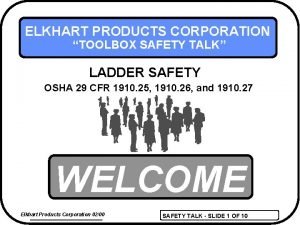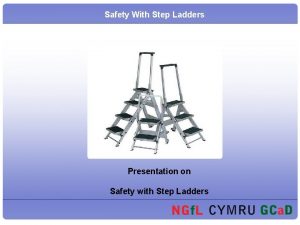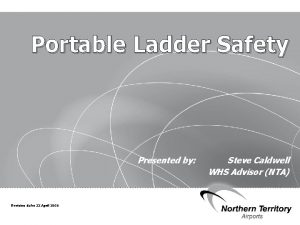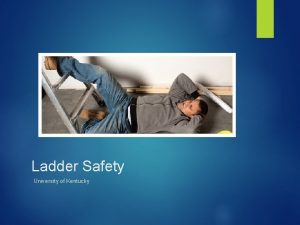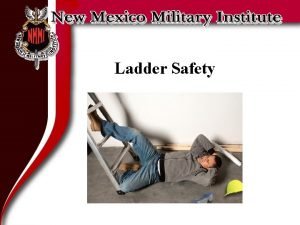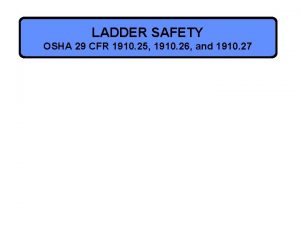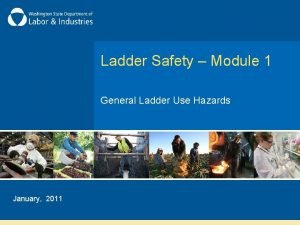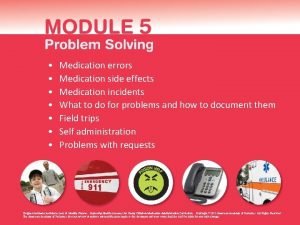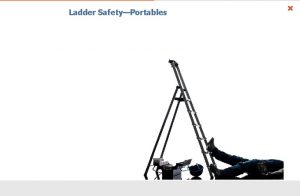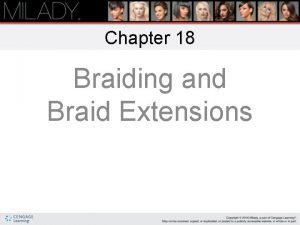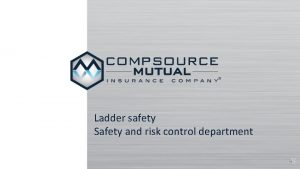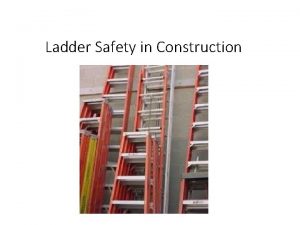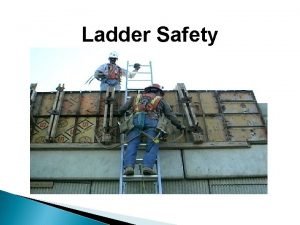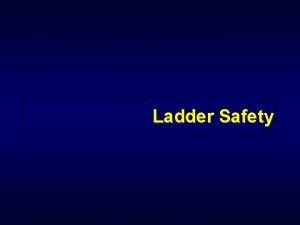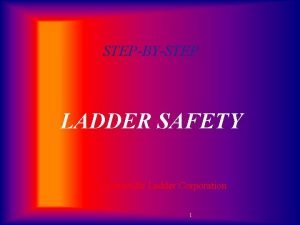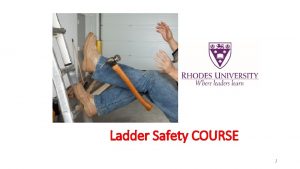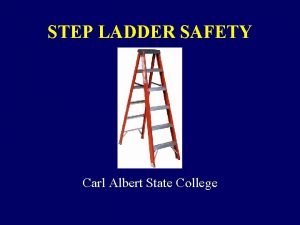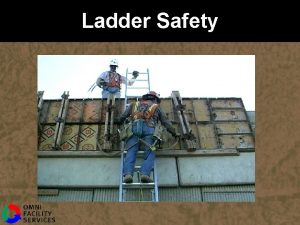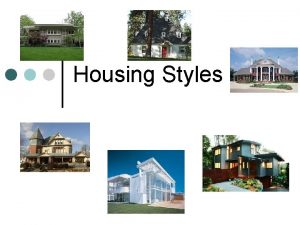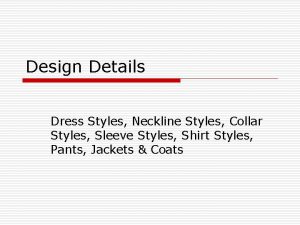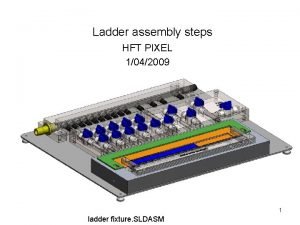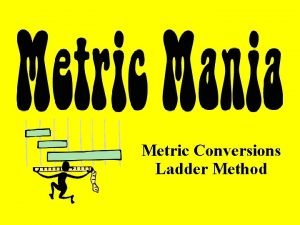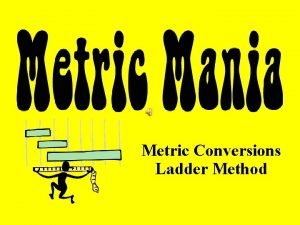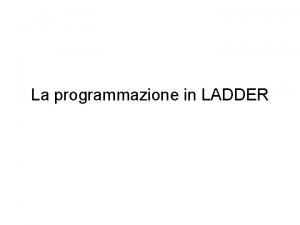Ladder Safety Module 2 Styles and Types of






























- Slides: 30

Ladder Safety – Module 2 Styles and Types of Portable Ladders January, 2011

Styles and Types of Portable Ladders Topics Covered 1. Introduction 2. Self-Supporting Ladders 3. Non Self-Supporting Ladders 4. Special Purpose Ladders

Introduction Portable ladders are either self-supporting (can stand up on their own) or non-self-supporting (need to lean against something). The standard general-purpose types of portable ladders are described in this module.

Self-Supporting Ladders (Step Ladders) Portable self-supporting ladders can stand up on their own. Standard stepladders have a front section with steps for climbing and a back section with two rear legs, which give them their stability. They must be set up on firm, level surfaces such as floors, platforms, and slabs. Front section Back section

Self-Supporting Ladders (continued) The standard stepladder is nonadjustable and has flat steps and a hinged back. It must have a metal spreader or locking device strong enough to securely hold the front and back sections in the open position. The back section is cross-braced and you cannot use it for climbing. Bucket Shelf Spreader

Self-Supporting Ladders (continued) The ladder may also have a bucket shelf which must be able to support a load of 25 pounds. Standard stepladders are usually intended for use by only one worker at a time, unless otherwise specified on the manufacturers' or other labels. Bucket Shelf

Self-Supporting Ladders (continued) Front rails are joined by horizontal flat steps at The flat crosspieces of a stepladder on regular intervals to form the front section of a which a person climbs up and down stepladder. The front section is the side of the TOP CAP Is not for the ladder. They must be regularly ladder intended for climbing. spaced, parallel and attached securely stepping onto. to the front rails. Parts of the Self-Supporting Ladders If present, it must be fastened so that it can be folded up within the ladder when the ladder is closed. It must be able to support a load of 25 pounds. Never lean or stand on the bucket shelf – it is not made to be able to support your weight TOP STEP Is not for stepping onto. Top Cap Bucket Shelf Top Step Click the labels to see an The spreader securely holds and locks the front and back sections of a explanation of each part of stepladder in the fully open position. the ladder. Click the label again to close the Crosspieces or diagonals that join the rear rails to stabilize and support them. They are part of the explanation window. back section and are not intended for climbing on a Spreader Steps Rear Brace Front Rails Rear Rail standard stepladder. Knees KNEES: (Truss) braces provide extra The support members of the back section of a support and reinforcement to the steps. stepladder. They are joined by bars or other bracing The bottom-most surfaces of the rails that are in contact with to form the back section. the ground or supporting surface. Metal and fiberglass stepladders must have slip-resistant feet or be covered with slip-resistant shoes. Feet

Non-Self-Supporting Ladders Non-self-supporting ladders must be leaned against a stable structure strong enough to support the weight of the ladder, user, tools and materials being used by the worker on the ladder. They are intended for use by only one worker at a time. Commonly used non-self-supporting ladders include single ladders and extension ladders.

Non-Self-Supporting Ladders (continued) The single or straight ladder has a wide range of applications and uses. Single ladders are nonadjustable and must never be tied or fastened together to form a longer ladder. Sectional ladders, which consist of two or more sections, are designed to be combined together to function as a single ladder

Parts of a Single, Non-Self-Supporting Ladder Side Rails Rung, Step or Cleat Feet

Extension Ladders Extension ladders offer convenience and the greatest length in a generalpurpose ladder. Fly or Upper Section Extension ladders consist of two or more sections that travel in guides or brackets that allow you to adjust the length of the ladder. The sections are assembled so that the sliding upper section (“fly”) is on top of the lower section when you are using the ladder. Lower Section

Extension Ladders The sections of an extension ladder are sometimes adjusted using ropes/cables and a pulley system to help raise and lower the sections. Rope & Pulley They must be equipped with positive stops to ensure the required overlap between the upper and lower sections. Ladder Length Minimum Overlap Up to and including 36 feet 3 feet Over 36 through 48 feet 4 feet Over 48 through 60 feet 5 feet Positive Locks

Special Purpose Ladders A special purpose ladder is a modification of a general purpose ladder, or a combination of design or construction features of general purpose ladders, that meet special needs for specific tasks. Only a few “special purpose” ladders are addressed here, but the general ladder safety rules and practices apply to these ladders as well.

Special Purpose Ladders (continued) If you are using a special purpose ladder, it is particularly important that you read and follow the manufacturers’ recommendations. Be sure to carefully read all labels on the ladder. You must also receive training on the ladder’s special uses and how to use it properly and safely.

Special Purpose Ladders – Platform Ladder The platform ladder is a special purpose ladder that has a large stable platform from which you can work at the highest standing level. The ladder's length is determined by the length of the front edge of the side rail from the bottom of the ladder to the base of the platform. It is useful for when you have to work for a period of time at one height. Photo courtesy of Bauer Corporation, Wooster, Ohio. Visit them at www. bauer. ladder. com

Special Purpose Ladders – Two Way Ladder The two-way or double-front stepladder is designed to be used on both sides, making it convenient and versatile. One person can work from either side or two people can work from the ladder at the same time, one on each side. Each side of the two-way ladder has a set of steps and must meet the requirements for the standard (oneway) industrial stepladder. Photo courtesy of Bauer Corporation, Wooster, Ohio. Visit them at www. bauer. ladder. com

Special Purpose Ladders – Tripod Ladders Some special purpose ladders, called tripod ladders, have three legs, which give them more stability on uneven surfaces and in areas where it is difficult to set up a standard stepladder, such as corners and other limited access areas. Orchard ladders have heavy use in tree fruit harvest and numerous falls occur during harvest season. Tripod construction ladder Link to orchard ladder safety online video Tripod orchard ladder

Special Purpose Ladders – Trestle Ladder A trestle ladder is a self-supporting portable ladder that has two sections hinged at the top, forming equal angles with the base. The rails must have spreaders or locking devices to keep them in place. They are designed for climbing on one or both sides at the same time by two workers, similar to the two-way ladder.

Special Purpose Ladders – Extension Trestle Ladder A variation of the trestle ladder, the extension trestle ladder, includes a vertically adjustable single ladder that can be locked in place. The single extension section cannot be longer than the base section size, which determines the size of the ladder, and must overlap at least three to six feet into the base section, depending on the size of the ladder. Extension trestle ladders are used in pairs to support planks or staging.

Special Purpose Ladders – Combination Ladder A combination ladder is an example of a special purpose ladder that can be used either as a stepladder or as a single or extension ladder. It may also be capable of being used as a trestle ladder. Different manufacturers may have other kinds of combination or multiple use ladders which are uniquely designed for specific uses.

Special Purpose Ladders – Articulated Ladder An articulated ladder is a portable ladder with one or more pairs of locking hinges which allow the ladder to be set up in several configurations such as a single or extension ladder, with or without a stand-off, a stepladder, a trestle ladder, scaffold or work table.

More Information L & I – Ladder Safety Webpage OSHA – Construction Ladder Misuse OSHA – Quick. Card Portable Ladder Safety Tips Ladder Safety. org Worksafe. BC – Safe Ladder Use – 13 minute online video Note: for review, 4 quiz questions with answers follow this slide

Portable Ladder Safety Self-Supporting Ladders Question 1 The back section of a standard stepladder is stabilized by braces which are used for climbing and descending. q True q False

Portable Ladder Safety Self-Supporting Ladders Question 1 - ANSWER The back section of a standard stepladder is stabilized by braces which are used for climbing and descending. q True q False The back section of a standard stepladder is NOT intended for climbing.

Portable Ladder Safety Self-Supporting Ladders Question 2 Which of the following statements are true regarding standard stepladders? q Never sit or stand on the bucket shelf q Climb only the front section of a standard stepladder q Make sure the front and back sections are fully open and the spreader is locked. q All of the above are true.

Portable Ladder Safety Self-Supporting Ladders Question 2 - ANSWER Which of the following statements are true regarding standard stepladders? q Never sit or stand on the bucket shelf q Climb only the front section of a standard stepladder q Make sure the front and back sections are fully open and the spreader is locked. q All of the above are true. Any or all of these answers can be correct.

Portable Ladder Safety Non-Self-Supporting Ladders Question 3 Extension ladders must have positive locks to ensure the correct overlap between sections. q True q False

Portable Ladder Safety Non-Self-Supporting Ladders Question 3 - ANSWER Extension ladders must have positive locks to ensure the correct overlap between sections. q True q False

Portable Ladder Safety Special Purpose Ladder Question 4 The trestle ladder was designed for use on uneven ground. q True q False

Portable Ladder Safety Special Purpose Ladder Question 4 - ANSWER The trestle ladder was designed for use on uneven ground. q True q False The tripod ladder was designed for uneven ground, not the trestle ladder.
 Convert extension ladder to orchard ladder
Convert extension ladder to orchard ladder Set-up trays and trolleys
Set-up trays and trolleys C device module module 1
C device module module 1 Vi go ladder climbing safety systems
Vi go ladder climbing safety systems Ladders and stairways
Ladders and stairways Trestle ladder safety
Trestle ladder safety Alliance toolbox talk ladder safety
Alliance toolbox talk ladder safety Patrick hudson safety culture
Patrick hudson safety culture Ladder safety ppt
Ladder safety ppt Ladder risk assessment checklist
Ladder risk assessment checklist Ladder safety
Ladder safety Ladder safety
Ladder safety Osha ladder storage
Osha ladder storage General ladder safety
General ladder safety 4 types of parenting styles
4 types of parenting styles Five types of conflict
Five types of conflict Formalism in film
Formalism in film Menu selection interaction styles
Menu selection interaction styles Learning style
Learning style 3 main types of leadership styles
3 main types of leadership styles Types of leadership styles
Types of leadership styles Supervisor development course module 2 answers
Supervisor development course module 2 answers Module 1 introduction to food safety
Module 1 introduction to food safety Medication safety module
Medication safety module Introduction to food safety answers
Introduction to food safety answers Module 1 basic safety
Module 1 basic safety Pyramid system tournament
Pyramid system tournament Ladder types ratings
Ladder types ratings What are the two vocal styles of singing in pakistan
What are the two vocal styles of singing in pakistan Explain the use of the square paddle brush in braiding
Explain the use of the square paddle brush in braiding Custom display in ecdis
Custom display in ecdis
